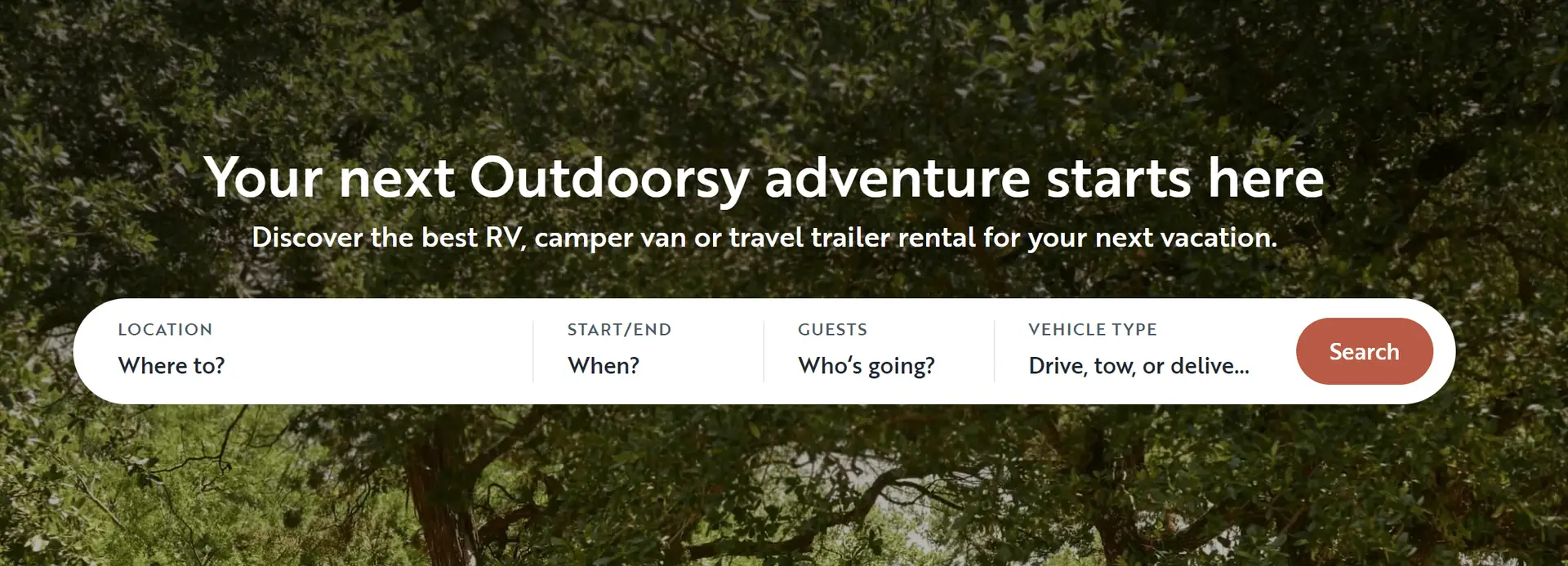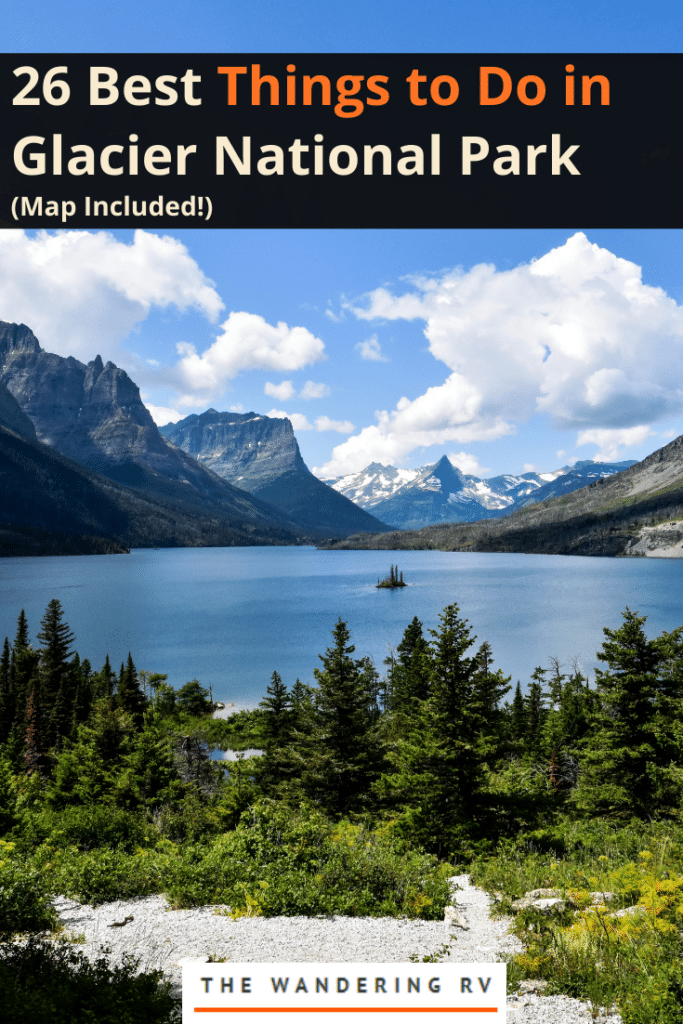
Are you planning a trip to Glacier National Park but aren’t really sure what you want to do yet?
Don’t worry – we’ve got you covered.
In this article, we go over all the things to do in Glacier National Park including hiking trails, where to see wildlife (such as mountain goats and bighorn sheep), where to stay, and more!
Let’s dive in!
Table of Contents
- Important Things to Know When Visiting Glacier
- Glacier National Park Map
- 26 Things to Do in Glacier National Park
- Glacier National Park Hiking Trails
- Sightseeing
- Activities
- Where to See Wildlife
- Where to Eat
- Where to Stay
- Final Thoughts
Important Things to Know When Visiting Glacier
Before we dive into the bulk of this article, there area few questions we’re asked and things you should know:
How many days do you need to explore Glacier National Park?
We recommend spending at least 3 – 4 days in Glacier National Park. This gives you enough time to check out a few hiking trails as well as visit the Two Medicine area to immerse yourself in the stunning alpine scenery.
Is Glacier National Park better than Yellowstone?
Glacier is half the size of Yellowstone, but is much more rugged. Meaning, you’ll need a bit more skill when hiking or mountain biking while at Glacier National Park. However, Yellowstone is known to be more abundant in wildlife.
Both parks are worth visiting but it really depends on what you want to do/see while there! If you’re in the mood for an adrenaline-filled adventure, we recommend Glacier. If you want a more relaxed trip, we recommend Yellowstone!
Best Time to Visit Glacier National Park
The best time to visit Glacier National Park is between late June and mid-September. Summer is the perfect time to drive the Going to the Sun Road, go fishing (or rafting) in the rivers, take full advantage of the beautiful hiking trails, and more!
However, depending on the activities you want to do in Glacier, the best time to go may change. For example, Spring is the perfect time to bike on the Going to the Sun Road as there’s much less traffic (assuming it’s open).
Spring is also a great time to visit Glacier National Park if you’re interested in going whitewater rafting! While you could go whitewater rafting in the Summer, Middle Fork of the Flathead River is at its peak height thanks to the spring runoff from the mountains.
Want to take an early morning hike while the leaves change colors? If so, Fall would be the ideal time for you to visit Glacier! From September through mid-October, hiking trails empty out for avid day hikers. The rivers aren’t as crowded either, which makes fly fishing more enjoyable!
Finally, if you love snowshoeing and cross country skiing, the Apgar Visitor Center in West Glacier remains open on the weekends (weather permitted).
Note: Be sure to visit the National Park service website to keep an eye on the weather conditions and any alerts in effect.
Glacier National Park Map
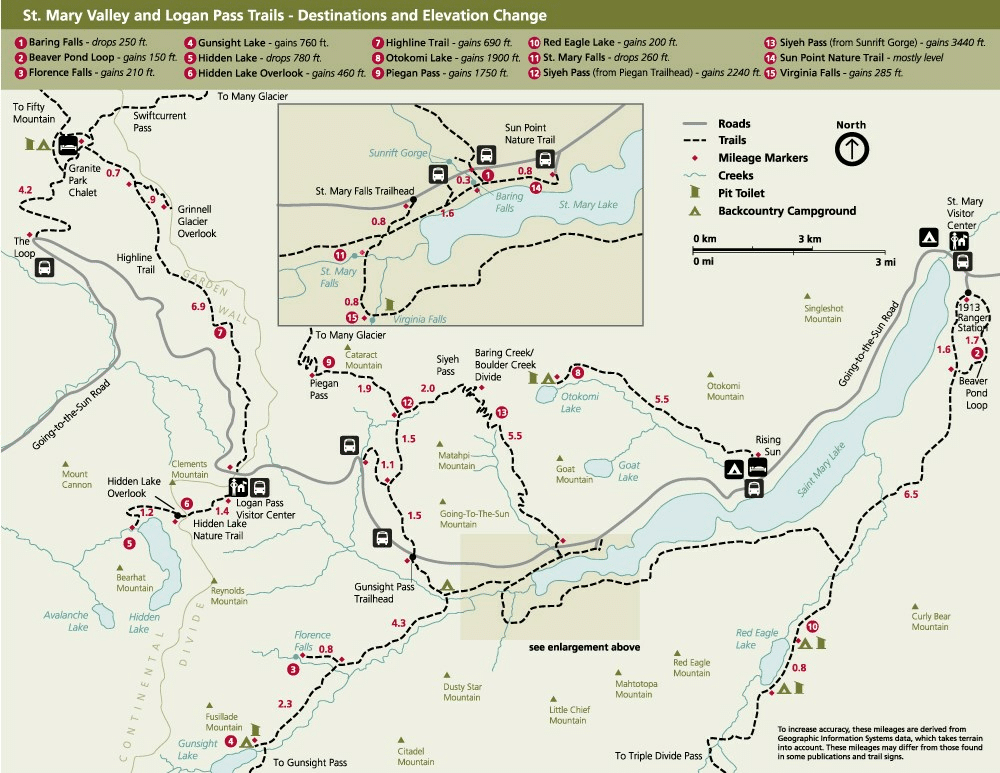
26 Things to Do in Glacier National Park
Glacier National Park has over a million acres to explore and it can be tough to do everything in one trip (unless you stay for an extended period of time).
Between visiting Lake McDonald, Avalanche Gorge, driving on the Going to the Sun road, or partaking in the Grinnell Glacier hike, you’ll find plenty of things to do in Glacier National Park for the entire family!
Glacier National Park Hiking Trails
The hiking in Glacier National Park is phenomenal. With wide enough trails to support two-way traffic, gorgeous views, and difficulty levels that range from inexperienced to experienced hiker, you and the family will have a blast!
Highline Trail
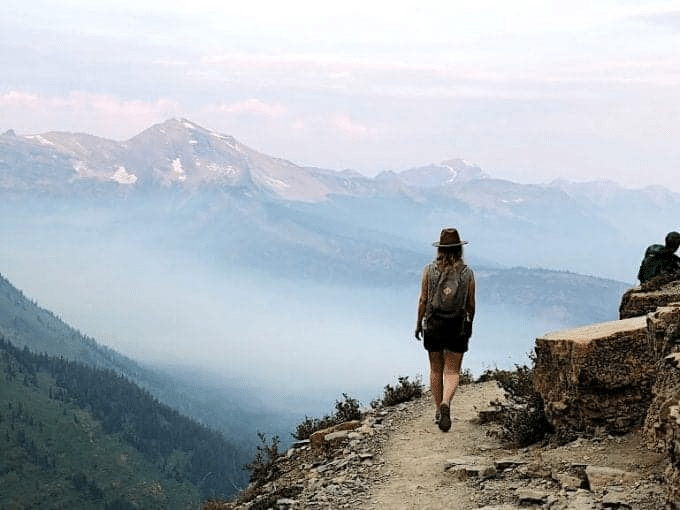
Known to be one of the most beautiful day hikes, Highline Trail delivers on both breathtaking views as well as wildlife (including bighorn sheep and mountain goats). The Highline trail is wide enough to support two-way traffic, too!
While this is known to be one of the most beautiful trails in Glacier, it’s not recommended for small children or those who have a fear of heights.
Grinnell Glacier Trail
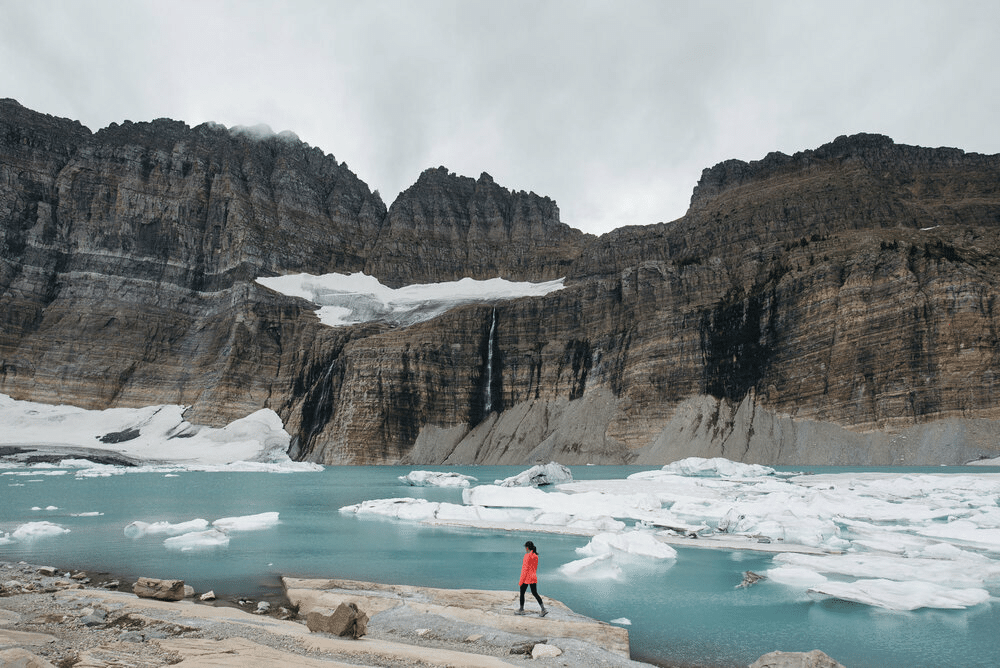
Grinnell Glacier lies within the Many Glacier region and offers 5.3 miles of some of the most iconic scenery in the park (the Grinnell Glacier overlook is worth the miles it takes to get there). The first two miles of this hike are pretty easy and you’ll cross the banks of Lake Josephine while on it.
This trail is filled with icebergs and mountain peaks known as the Garden Wall. We highly recommend you hike Grinnell Glacier while in the area (but be sure to bring a coat as it tends to get cold)!
Avalanche Lake
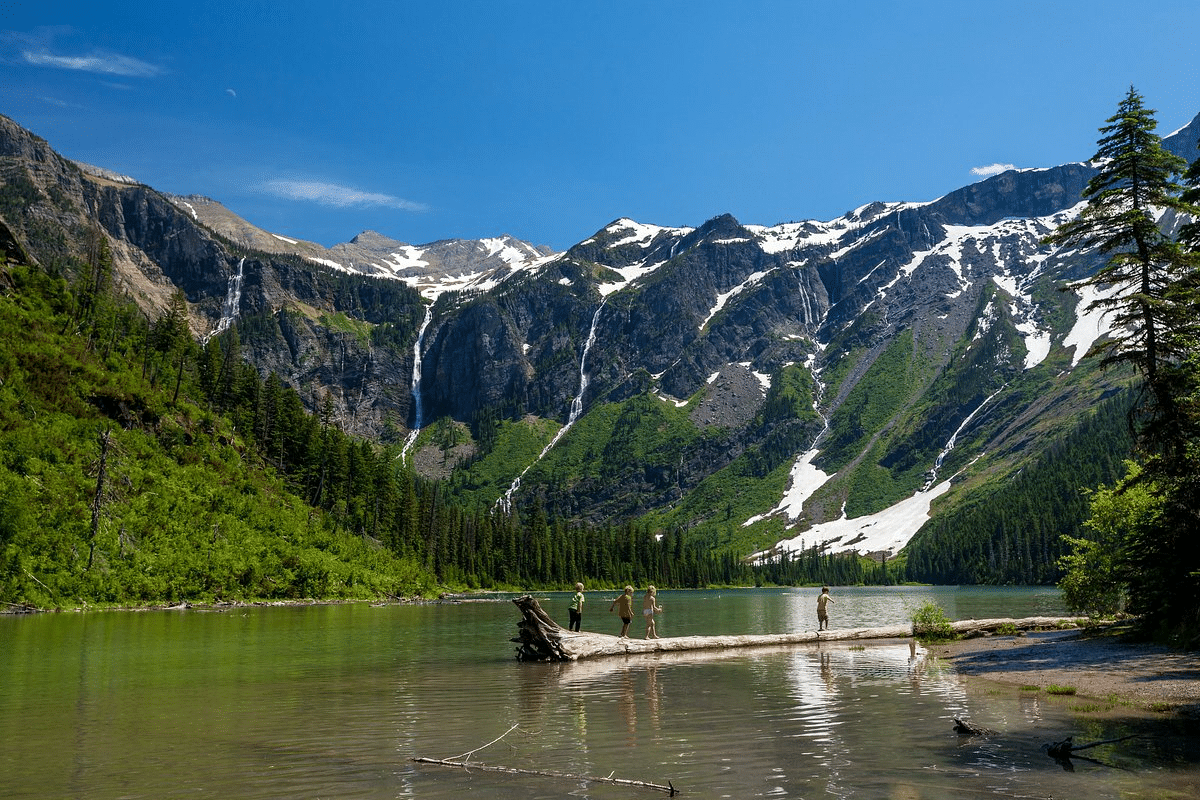
Avalanche Lake is one of the best short hikes in Glacier National Park. It’s a 2.3 mile long trail that traverses alongside the carved banks of Avalanche Creek with a total elevation gain of 500 feet.
It’s perfect for those who aren’t looking for an intense hike, but still want to have a bit of an adventure! The trails at Avalanche Lake are wide enough to support two-way traffic, too.
Halfway through the trail, you’ll pass through a massive tree that had fallen from an avalanche (hence the name). Hiking this trail and getting to see Avalanche Lake is not only easy, it’s rewarding and beautiful!
Hidden Lake Trail
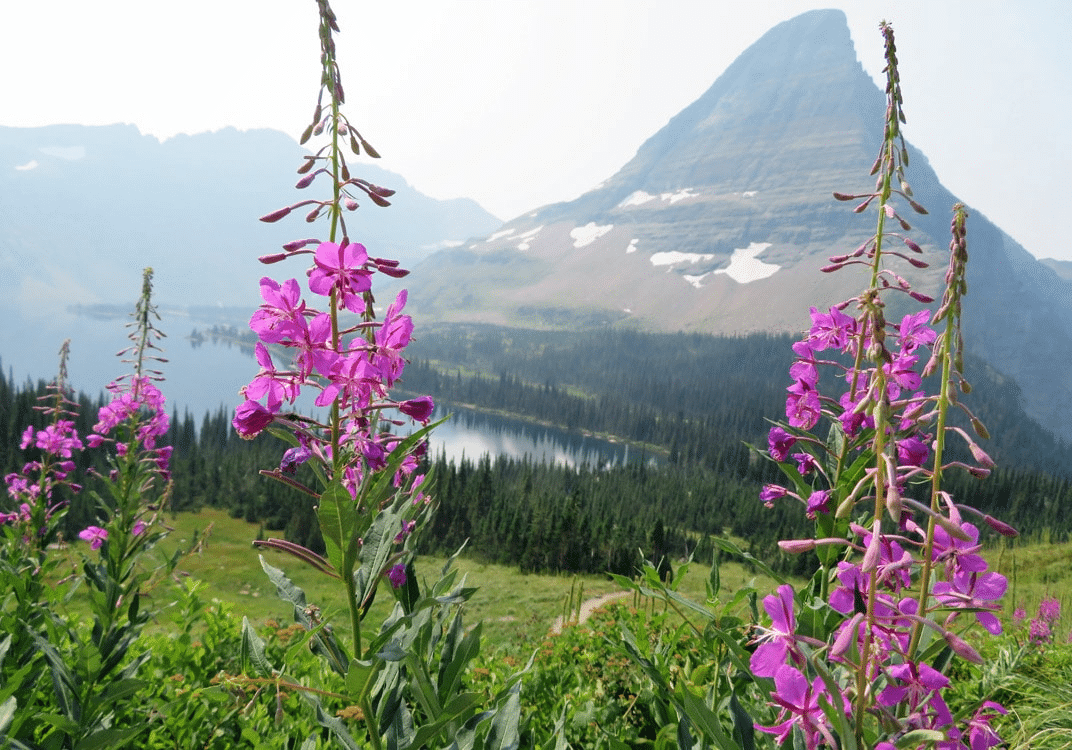
On the west side of the Logan Pass Visitor Center sits Hidden Lake Trail. This 2.6 mile long trail crosses through Hanging Gardens, where wildlife and wildflowers can be seen (bighorn sheep and marmots are known to be spotted on this trail)!
Note: You won’t always find parking here – we recommend you leave very early in the morning or ride the free Going to the Sun Road shuttle to Logan Pass.
Iceberg Lake
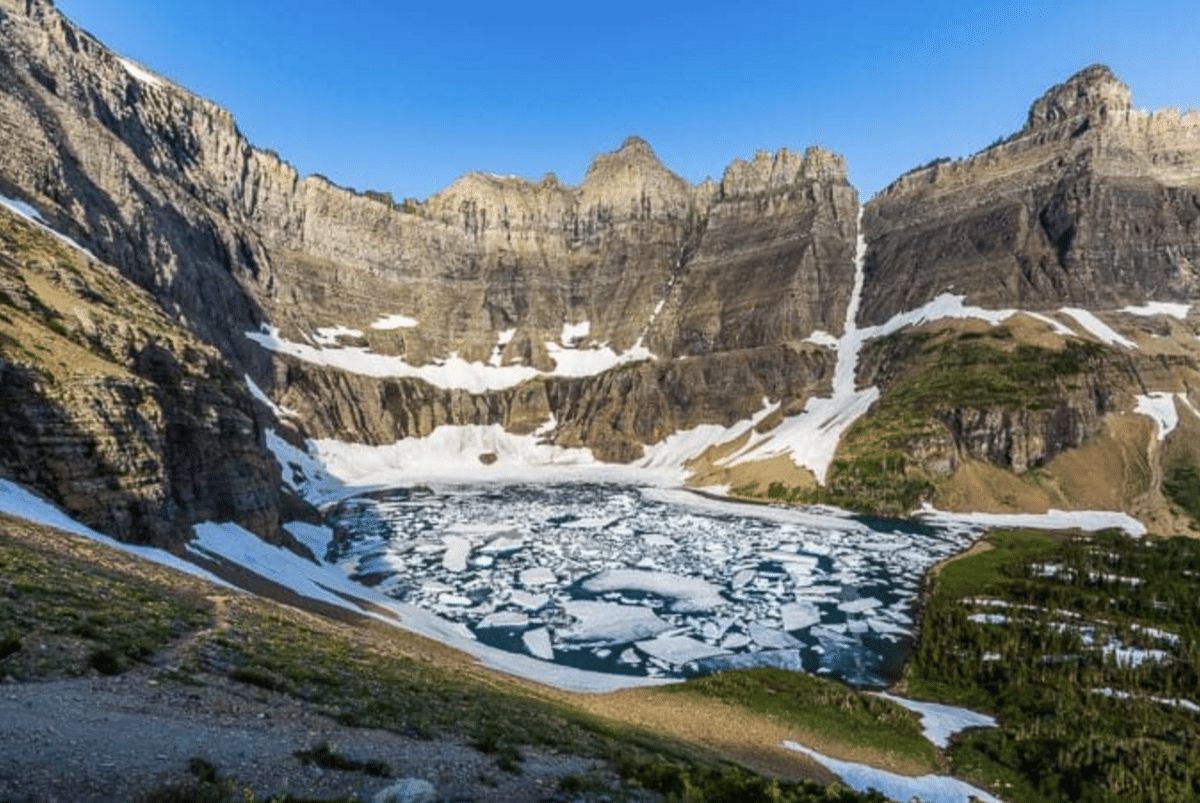
Looking for a good day hike? Iceberg Lake is 4.5 miles and 1,200 feet up an icy body of water (hence its name). This is a pretty popular hiking trail in the summer but it’s wide enough for two-way travel!
Near the end of the trail, you’ll encounter vibrant alpine meadows before descending into the bowl of Iceberg lake and, depending on the time of year you visit, the lake may have receded!
Note: Bears and other wildlife are known to be on this route – be sure to bring your bear spray!
Sightseeing
It’s hard to point out just a few places to go sightseeing while in Glacier National Park. The entire park offers beautiful panoramic views and, truth be told, some people don’t even want to leave the Glacier hotel when they’re there because of how beautiful (and peaceful) it is!
If you’re a lake lover, we recommend going to:
Avalanche Lake
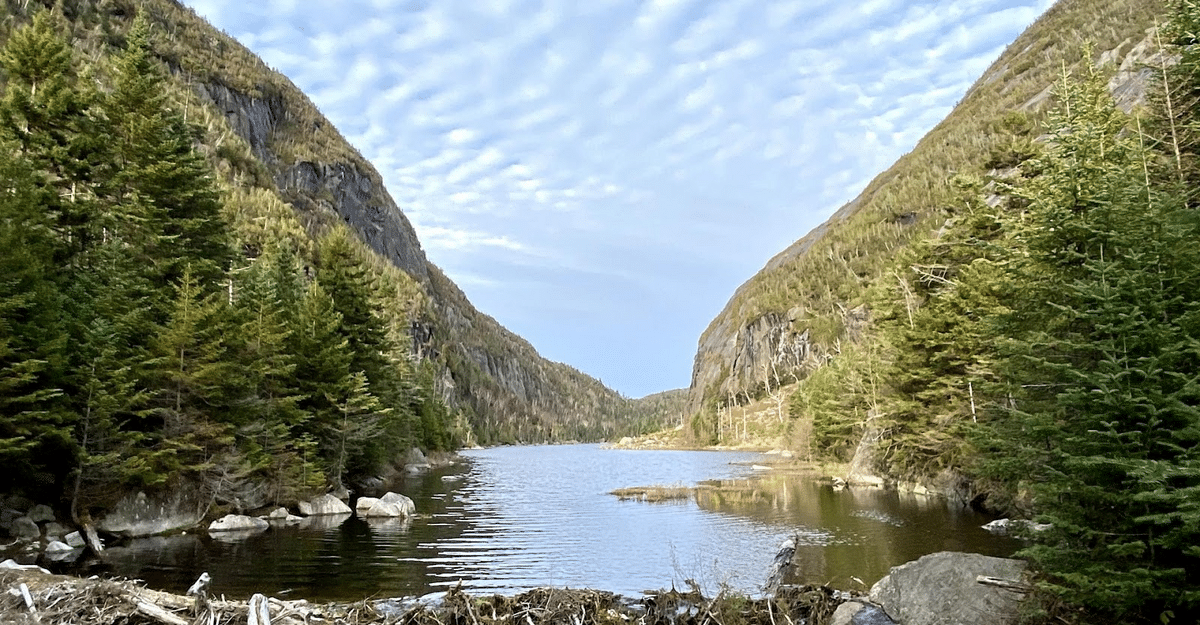
This lake is rimmed with steep cliffs and has numerous cascading waterfalls. Between birdwatching, wildlife viewing, and plenty of picnic spots, you’re sure to find tons of beauty around Avalanche Lake.
Note: Be sure to bring your bear spray if you plan on hiking around Avalanche Gorge! You’re more likely to see a wild bear than not (and it’s better to be safe than sorry). This is grizzly bear country after all!
Lake McDonald
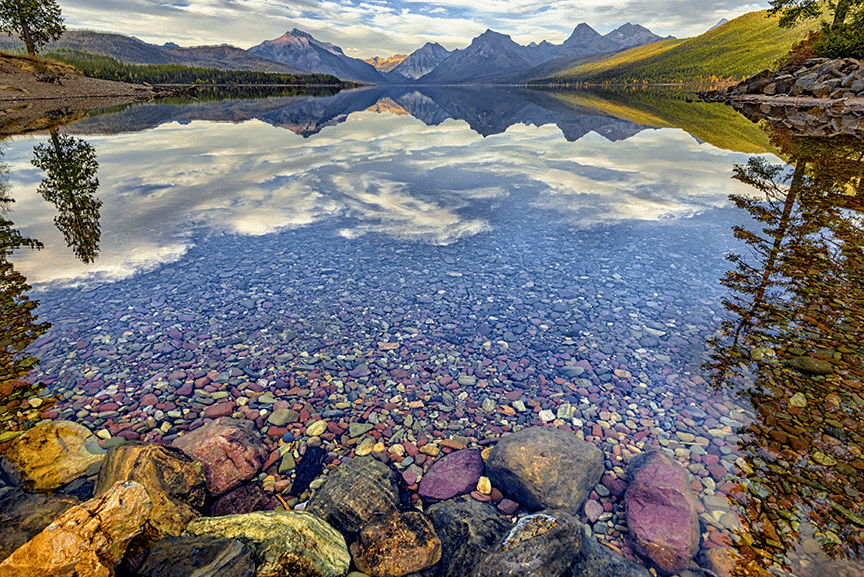
Lake McDonald is one of our favorite places to visit when we’re in Glacier National Park. Not only do you get stunning views while you’re here, there are colorful rocks in the lake (thanks to the iron in the air that oxidized them).
This lake is the largest lake in Glacier National Park and you’re able to swim, fish, kayak, and canoe while here! We highly recommend you visit Lake McDonald while in Glacier!
Note: As pretty as these rocks are, it’s important to remember that it’s against the law to take rocks, stones, flowers, and anything naturally found in a National Park.
Hidden Lake Overlook
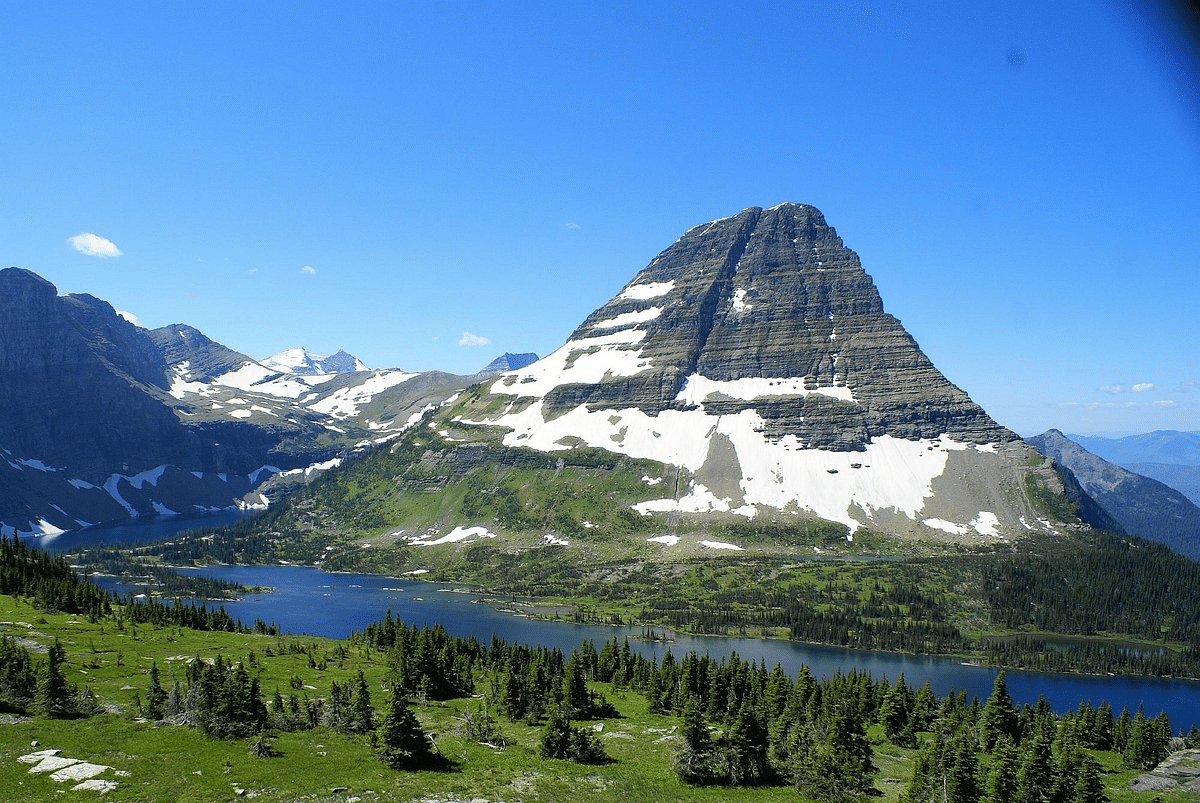
Between the snow capped mountains in the summer, fields of wildflowers, and panoramic views, Hidden Lake Overlook is a must-see while at Glacier National Park. You’ll see Rocky Mountain goats while here as well as plenty of flora and fauna!
Two Medicine Lake
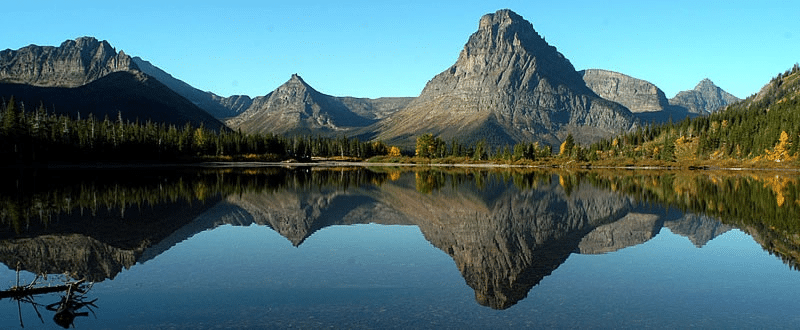
Looking for a place to go sightseeing on the path less traveled? Two Medicine Lake is for you. This beautiful lake isn’t visited as much as other Glacier lakes, but don’t let that keep you away. In fact, we recommend you go there first!
Not only does Two Medicine have dramatic views, reflective lakes, and plenty of waterfalls, there’s also a campground, picnic areas, camp store and gift shop, and scenic boat tours and rentals.
Saint Mary Lake
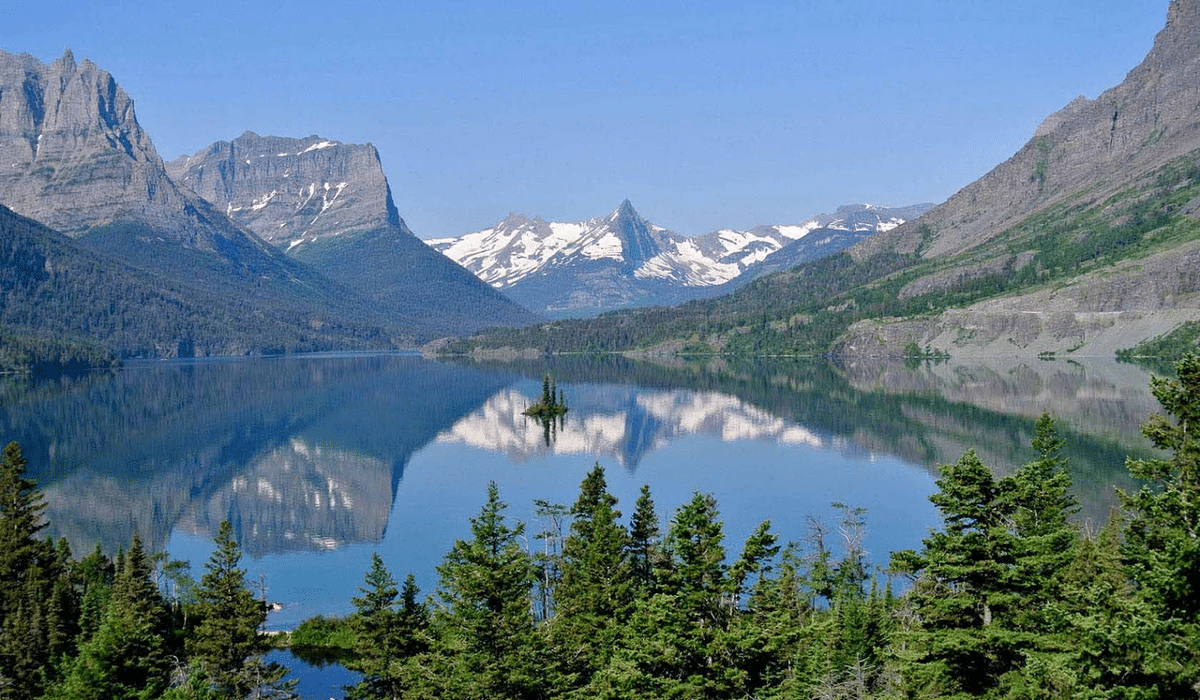
Saint Mary Lake is a 10-mile long lake with stunning views and an abundance of wildlife (including elk, grizzly and black bears, and mule deer).
During the summer, you’ll see wildflowers on the hillsides, in the fall the trees are bright orange and yellow, and in the winter you’re able to go snowshoeing.
Flathead Lake
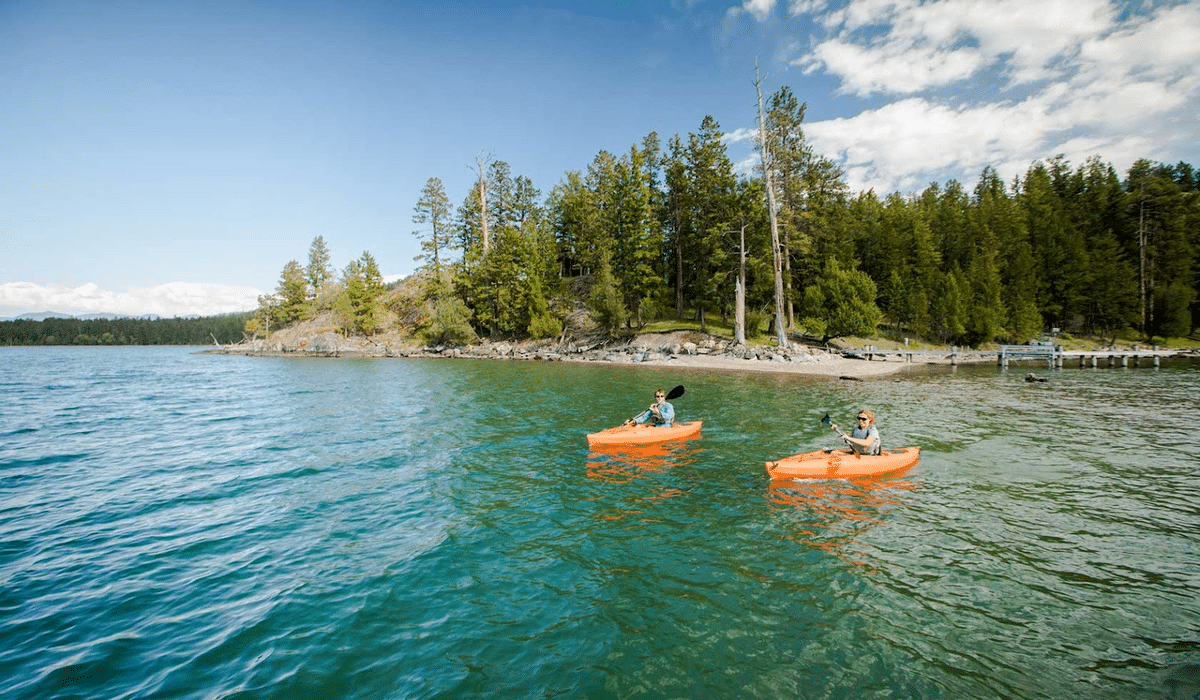
Created by Ice Age glaciers, Flathead Lake is nearly 30-miles long (and 15-miles wide) and is the largest natural lake in western America.
With panoramic views, whitewater rafting opportunities, trout fishing, and more, Flathead Lake is an amazing place to spend your time while at Glacier National Park.
You don’t have to go to a lake to see some pretty stunning views, though! For example, if you were to drive on the Going to the Sun road, you’d see panoramic views no matter where you looked. There are plenty of places you can pull off and take pictures while there, too.
Logan Pass is also a great place to see flora and fauna. The Logan Pass visitor center offers ranger-led activities for the whole family, too!
Activities
With all of the things to do in Glacier National Park, it can seem a bit overwhelming.
Fishing at Lake McDonald (or on Hidden Lake), biking the Going to the Sun road, or ranger-guided tours are just a few things you can do while in Glacier!
Skiing and Snowshoeing
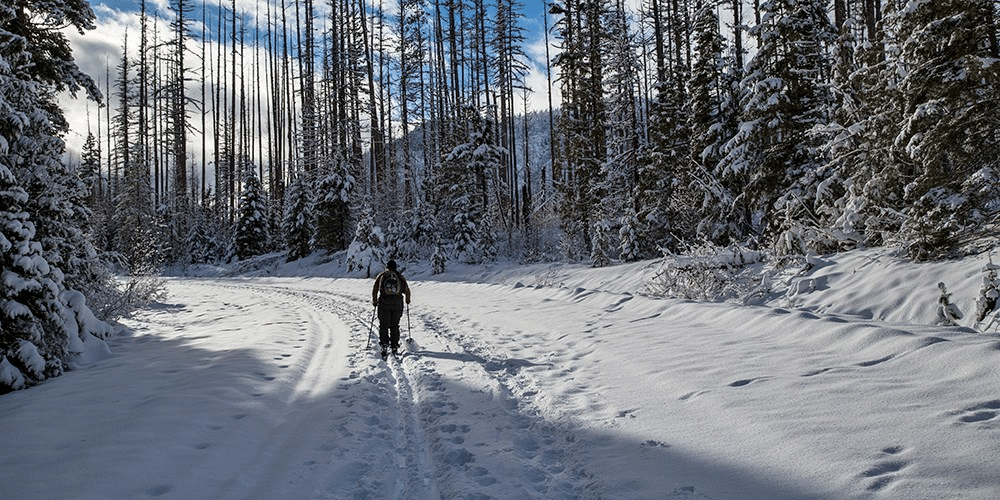
While you’re able to go skiing and snowshoeing in Glacier National Park all winter, it’s important to know that most roads in Glacier National Park close due to extreme weather. However, Going to the Sun road from West Glacier to Lake McDonald Lodge is plowed and open year-round, weather permitting.
Not only that, the Apgar and Logan Pass Visitor Centers are closed during the winter months. That said however, the restrooms at the Apgar Visitor Center are open throughout the winter.
There are plenty of places to go skiing and snowshoeing in Glacier National Park (click here for a downloadable PDF on where you’re able to go)!
Here are the places included in the downloadable PDF:
- Apgar Lookout
- Lower McDonald Creek
- Rocky Creek
- Site of Old Flathead Ranger Station
- McGee Meadow Loop
- McDonald Falls
- Sacred Dancing Cascade
- Avalanche Picnic Area
- Big Prairie
- Bowman Lake
- Covey Meadow
- Lone Pine Prairie
- Two Medicine Road
- Beaver Pond Loop
- Red Eagle Lake Trail
Before you plan a visit to go skiing and snowshoeing, we highly recommend you go to the Glacier National Park website to make sure the weather conditions aren’t too extreme.
Guided Tours
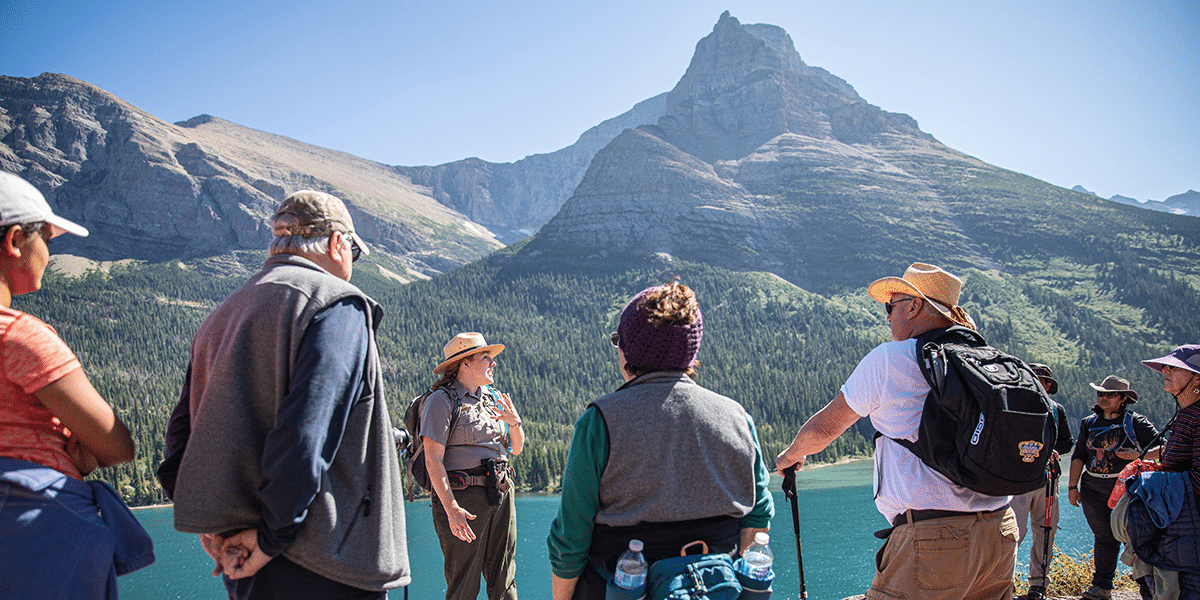
The National Park service at Glacier has tons of ranger-led activities and tours to partake in. You can choose from:
- Take a boat tour around Many Glacier, Lake McDonald, Two Medicine, and Rising Sun.
- Bus tours that take you through West Glacier, East Glacier, St. Mary, and Browning during the peak season.
- Hiking and backpacking trips in and around Glacier’s backcountry.
- Guided raft tours around Middle Fork (and North Fork) of the Flathead river.
- Guided horseback rides at Many Glacier, Lake McDonald, and Apgar.
They also offer educational programs for all ages!
Biking
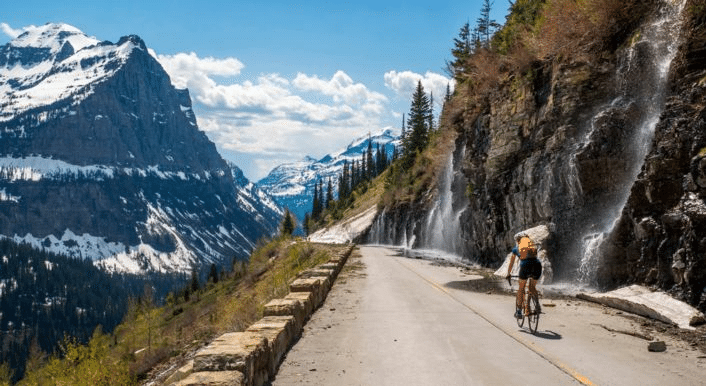
In Glacier National Park, you’re able to ride portions of the Going to the Sun Road. While bicycling is something you’re able to do throughout the Spring and Summer months, it’s important to remember that during the Summer there’s heavy vehicle traffic on the Going to the Sun Road and only experienced bikers should ride during peak summer season.
Note: There is a biker fee of $5 per person per night for Apgar, Sprague Creek, Avalanche, Many Glacier, Two Medicine, and Rising Sun Campgrounds. In reservation campgrounds, St. Mary and Fish Creek, the fee is $8 for the first person and $5 for every individual beyond the first.
Fishing
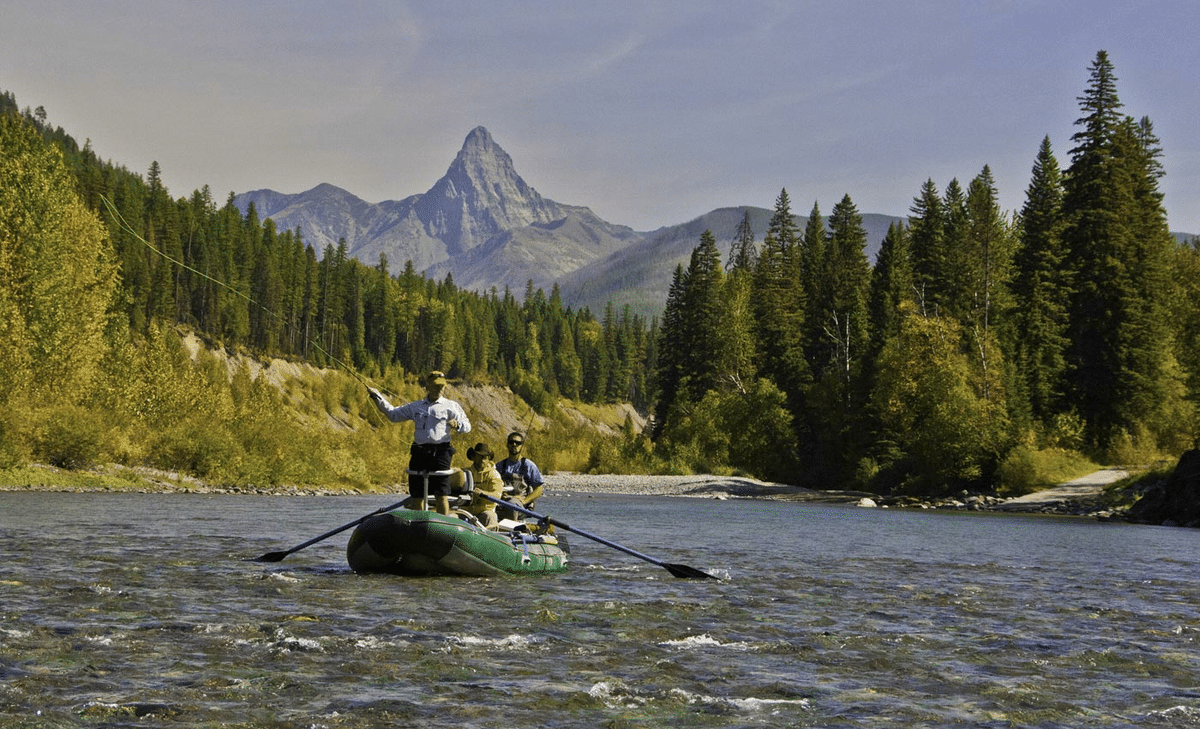
While a primary purpose of Glacier National Park is to preserve natural ecosystems for their aesthetic, educational, cultural, and scientific values, fishing is permitted when consistent with preservation or restoration of natural aquatic environments.
You don’t need a fishing license to fish inside of park boundaries. It’s recommended that you wet your hands with lake, river, or stream water before handling fish. No bull trout may be retained. Any and all caught accidently must be handled with care and released immediately. If you plan on keeping fish to eat, please check the fish consumption guidelines.
Currently, the following areas are closed to fishing:
- Kintla Creek between Kintla Lake and Upper Kintla Lake
- Upper Kintla Lake
- Akokala Lake
- Bowman Creek above Bowman Lake
- Logging Creek between Logging Lake and Grace Lake
- Cracker Lake
- Slide Lake and the impounded pond below the lake
- The following creeks are closed for their entire length: Ole, Park, Muir, Coal, Nyack, Fish, Lee, Otatso, Boulder, and Kennedy Creeks.
- North Fork of the Belly River
- North Fork of the Flathead River within 200 yards (183 m) of the mouth of Big Creek
With that said, here’s what you can expect to catch (and where):
- Flathead River native fish: bull trout, westslope cutthroat trout, mountain whitefish, suckers, northern pikeminnow
- St. Mary/Belly/Waterton River native fish: bull trout, lake trout, burbot (ling), westslope cutthroat trout, northern pike, lake whitefish, mountain whitefish, suckers. Exception with St. Mary Lake – No more than 5 fish may be harvested and possessed in combination with the following limits on individual species: 2 burbot (ling), 5 lake trout, 1 northern pike, 2 cutthroat trout, 2 mountain whitefish, and 5 lake whitefish.
- Two Medicine and Cutbank Creek native fish: westslope cutthroat trout in Midvale and Railroad creeks only
- Flathead River Drainage non-native species: Yellowstone cutthroat trout (Fish, Hidden, and Grace lakes only), lake trout, lake whitefish, kokanee, rainbow trout, and brook trout
- St. Mary River/Belly/Waterton River non-native species: Yellowstone cutthroat trout (in all lakes except St. Mary Lake: see above), rainbow trout, brook trout, and grayling
- Two Medicine and Cutbank Creek (Missouri River) non-native species: lake trout, brook trout, Yellowstone cutthroat trout, and rainbow trout
Note: All native fish caught must be released. There is no daily catch or possession limit on non-native fish species in the park.
Boating
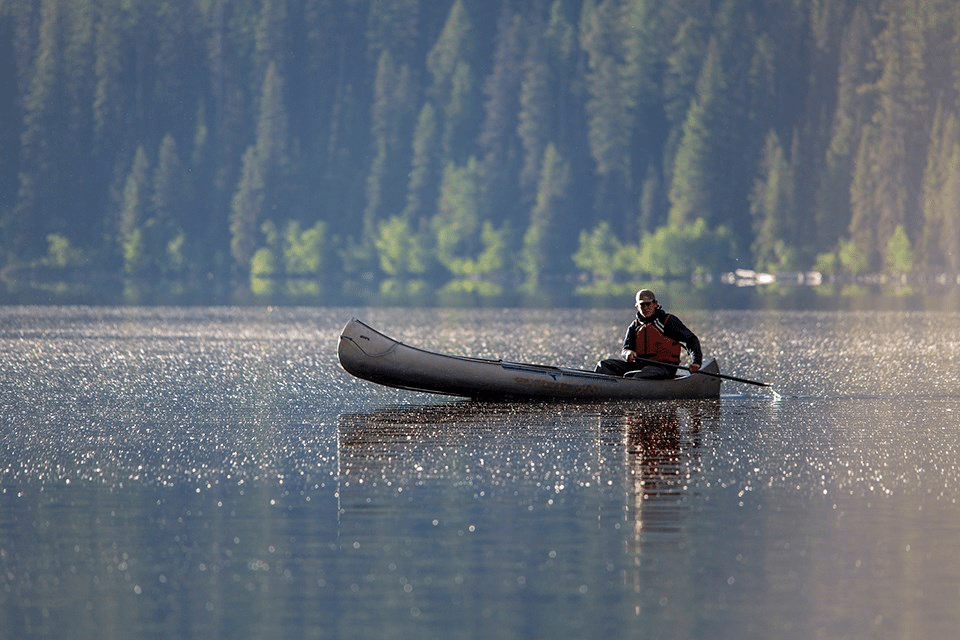
Of all the things to do in Glacier National Park, boating may be the most relaxing. Whether you go on Lake McDonald, the Kintla and Bowman Lakes, Two Medicine Lake, St. Mary Lake, or Sherburne and Swiftcurrent Lake, you’re sure to have a blast! Click here to see available dates and times while in Glacier National Park.
You can go out alone or on a boat tour, too!
Note: All watercraft launched within Glacier National Park MUST be inspected for aquatic invasive species (AIS) prior to launching.
Backcountry & Wilderness Camping
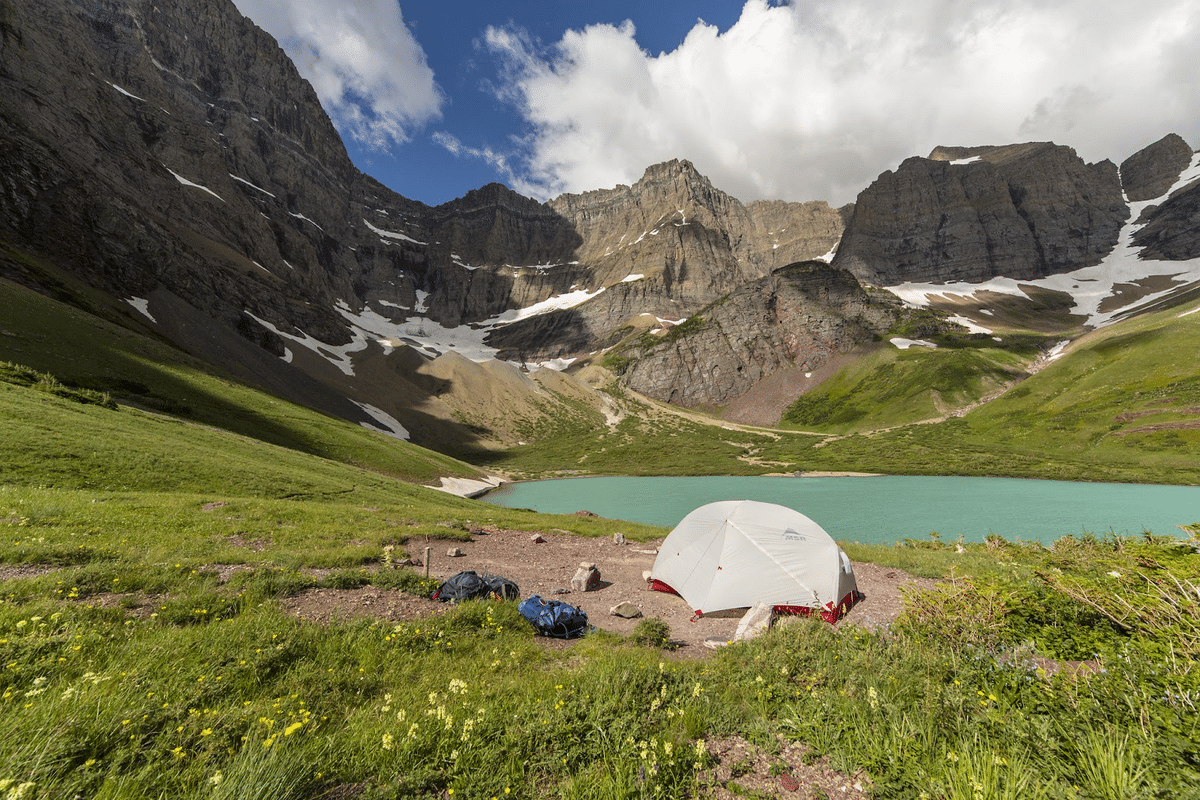
Camping may be one of the most fun things to do in Glacier National Park! There are so many ways to camp in Glacier, too.
- Read this if you’re a fan of Wilderness camping.
- Read this if you’re interested in a first-come, first-served campground.
- Read this if you want to stay in a Reservation campground.
There are a limited number of sites at Apgar, Fish Creek, Sprague Creek, and Two Medicine for those traveling on foot or bicycle. These sites are shared and can fit up to 8 people (larger groups must split up or use group sites where they’re available.
There’s a fee of $5 per night for Apgar, Sprague Creek, and Two Medicine. At Fish Creek, the fee is $8 for the first person and $5 for each person beyond that.
Those who travel on motorcycles must use regular, unoccupied campsites. The hiker/biker sites are for non-motorized campers only.
If you know that you’ll be camping while in Glacier National Park, why not go prepared? Use these camping hacks before you even hit the trails!
Note: While you could partake in dispersed camping while at Glacier National park, it’s important to remember that bears, mountain lions, and other wild animals all roam about Glacier (especially at night!). Keep your bear spray close and maintain 25 yards distance from all animals and 100 yards from bears and wolves.
Where to See Wildlife
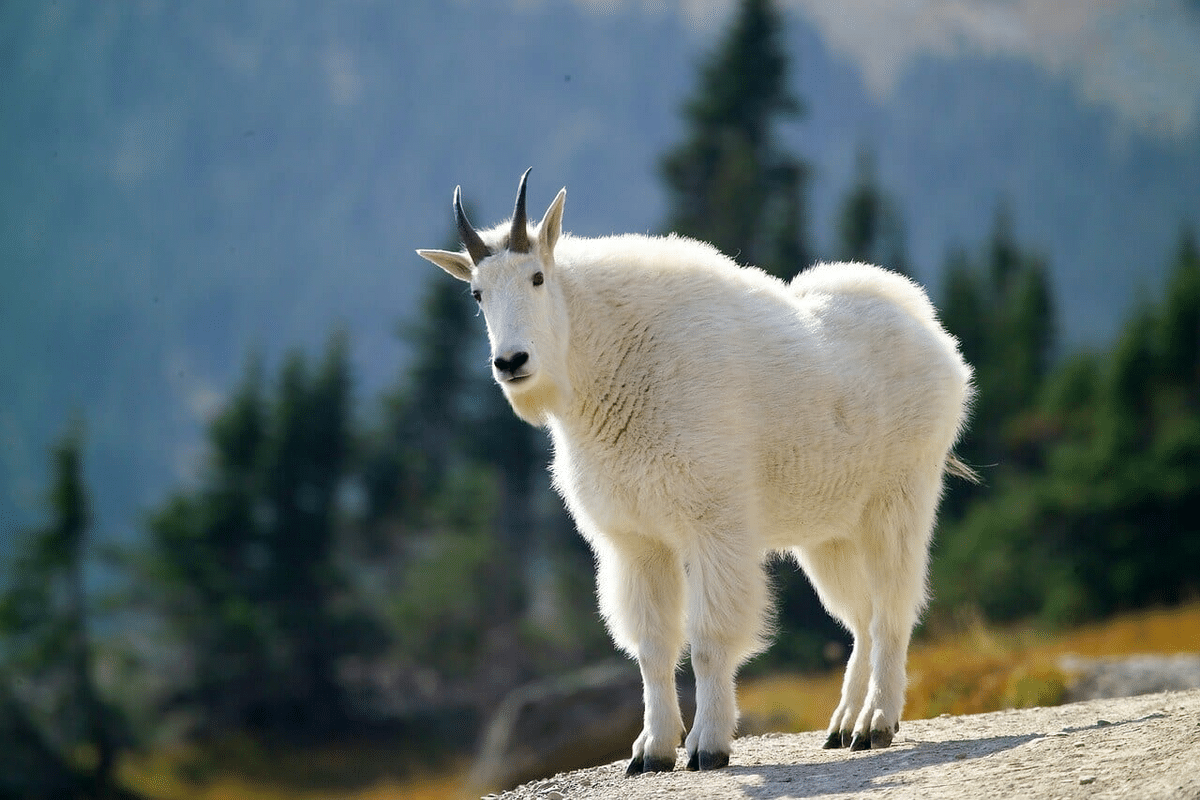
Glacier National Park is home to 71 species of mammals thanks to Glacier’s ecosystem being relatively undisturbed. This is thanks to two key things:
- The park was designated in the early 1900’s which gave wildlife over a century of protection.
- There’s plenty of space for all animals to survive (there are over a million acres at Glacier National Park).
Some of the animals you’ll see while at Glacier are:
- Pygmy shrews
- Bats
- Elk
- Bears
- Beavers
- Bighorn sheep
- Lynx
- Mountain goats
- Mountain lions
- Pikas
- Wolverines
Here’s a checklist for all mammals in Glacier National Park. Keep a safe distance from the animals – on the Glacier National Park website they recommend you keep bear spray on you at all times and maintain 25 yards distance from all animals and 100 yards from bears and wolves.
Where to Eat
Glacier National Park has all of the views you could ask for. But, what about food?
We found four of the best places to check out while exploring (and trust us, each place is equally as delicious as the next).
Tower Grill
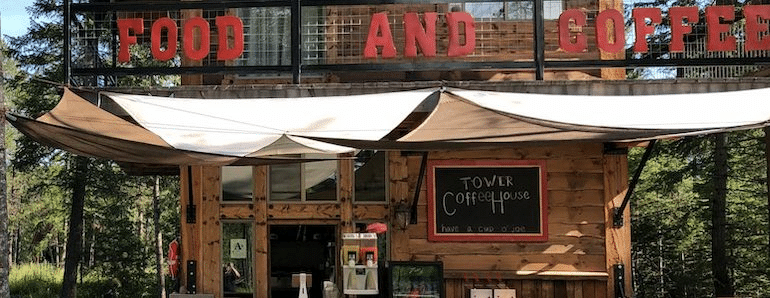
Tower Grill is an awesome place to grab a quick bite to eat in between ziplining and the high ropes course nearby. Not only can you get some delicious food, you’re able to get a variety of espresso drinks and ice cream!
Belton Chalet Restaurant and Tap House
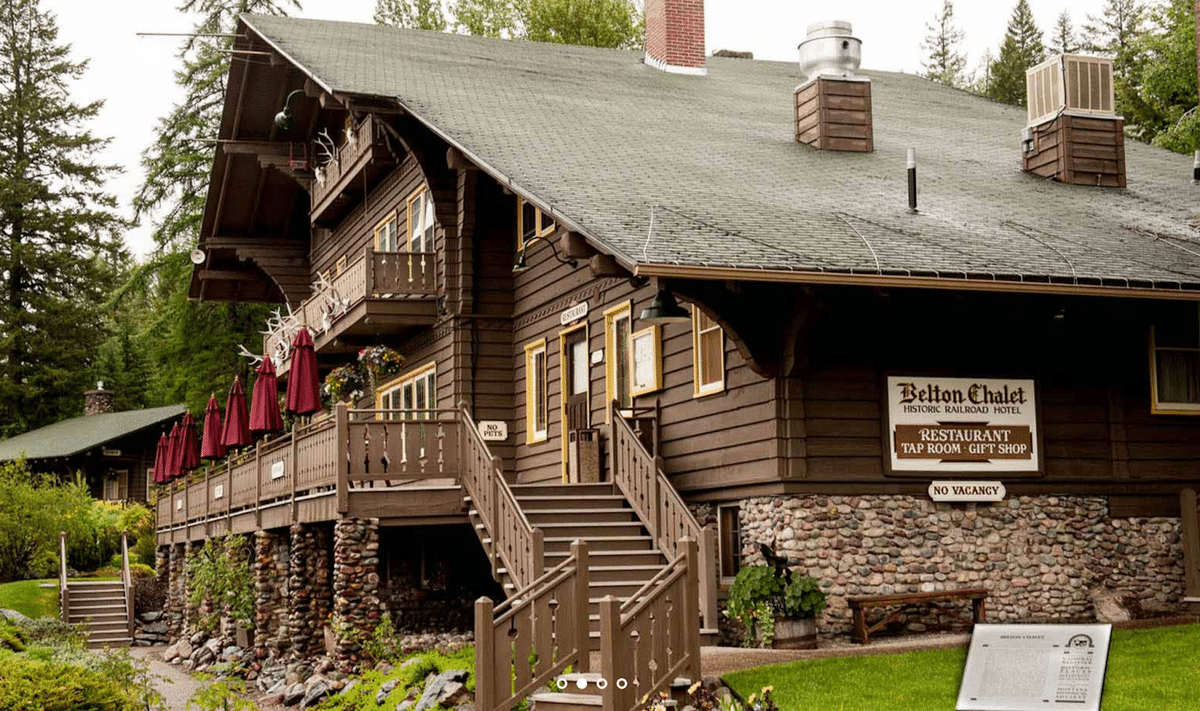
The Belton Chalet Restaurant and Tap House serves an array of local beer, spirits, and craft cocktails. It has an outdoor elevated deck and original 100-year-old fireplace, and this is one of the first iconic lodges built by the Great Northern Railroad! It may be expensive, but it’s well worth checking out while you’re looking for things to do in Glacier National Park.
The Tower Grill and Coffee House – Glacier Highline
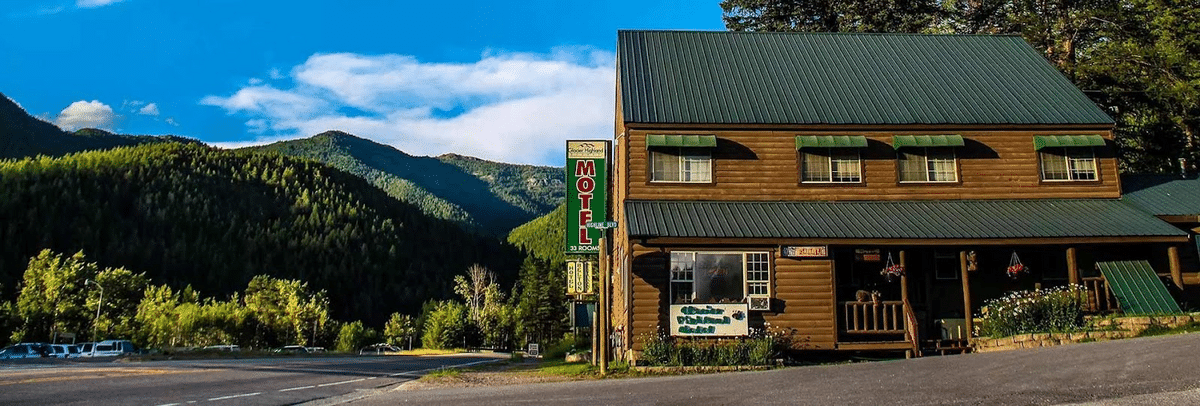
If you’re looking for an intimate family-style restaurant in Glacier National Park, look no further than The Tower Grill and Coffee House – Glacier Highline. No reservation is needed to dine here and everything on their menu is made fresh. Be sure to grab some of their famous huckleberry pie before leaving!
Josephine’s Speakeasy
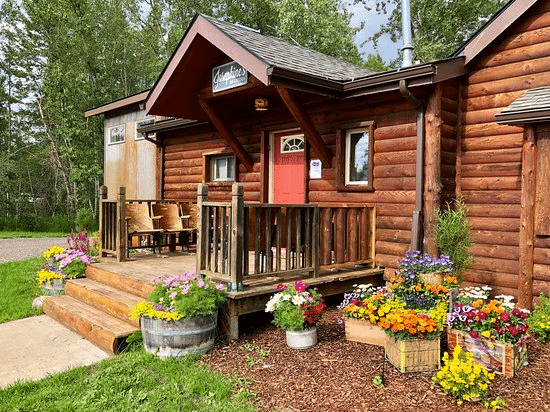
Looking for a hidden gem in Glacier National Park? Josephine’s Speakeasy may be the spot for you. With seasonal cocktails and specials that change weekly, you never know what you’ll get at Josephine’s!
Where to Stay
So, you know you want to visit Glacier National Park… but where should you stay? Whether you want to stay at the Many Glacier Hotel, the Lake McDonald Lodge, or at an RV park, we’ve got you covered!
Historic Lake Mcdonald Lodge
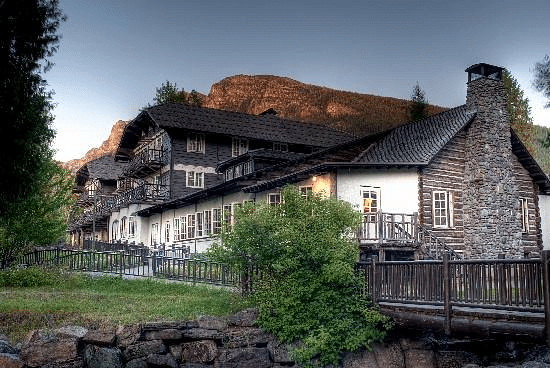
Built in 1913, the Historic Lake McDonald Lodge is a classic Swiss chalet style lodge, located just 10 miles inside of Glacier National Park’s west entrance on the Going to the Sun Road.
The lodge was renovated in 2015 and all rooms have a private bathroom. You could get a standard or deluxe room with one to two queen-sized beds.
When staying here, you get access to Russell’s Fireside Dining Room, Jammer Joe’s Grill and Pizzeria, Lucke’s Lounge, Creekside Reading Room, Red Bus tours, boat cruises, horseback rides, evening ranger programs, and more!
Many Glacier Hotel
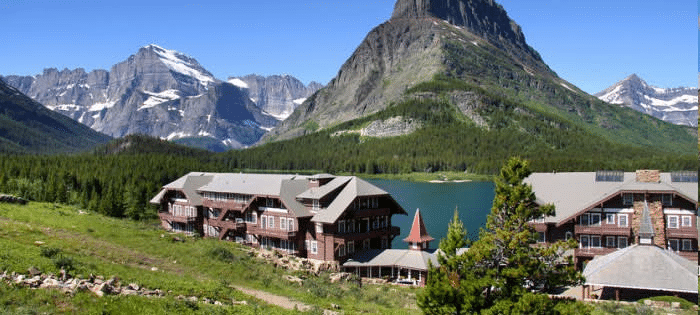
Many Glacier Hotel is the largest hotel in Glacier National Park. It was built in 1914-15 by the Great Northern Railway and is situated on the shores of Swiftcurrent Lake inside Glacier National Park.
While staying at Many Glacier Hotel, you’ll have access to the Swiss Lounge, Heidi’s Snack Shop, the lakeside Ptarmigan Dining Room, and a Gift Shop. Red Bus tours, boat cruises, horseback rides, evening ranger programs, and various other activities are also available at Many Glacier Hotel.
Glacier Park Lodge
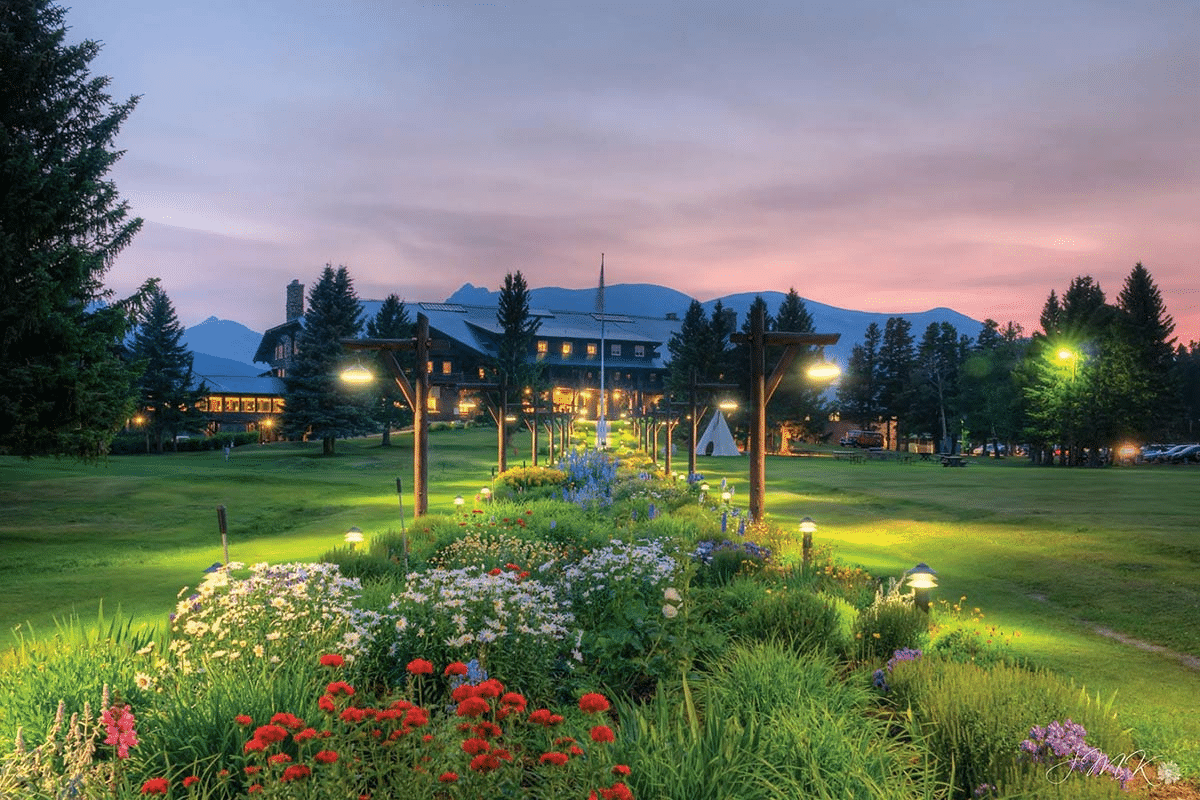
Glacier Park Lodge was the first hotel built by the Great Northern Railway in 1913. It took a crew of 75 men a year and a half to construct the two main buildings!
With a gorgeous dining room and golf course on site, you won’t even have to leave the lodge to enjoy your time! They also allow you to have your wedding on site!
Note: Glacier Park Lodge is booking for 2023 – but they’re closed for the 2022 season.
West Glacier RV Park
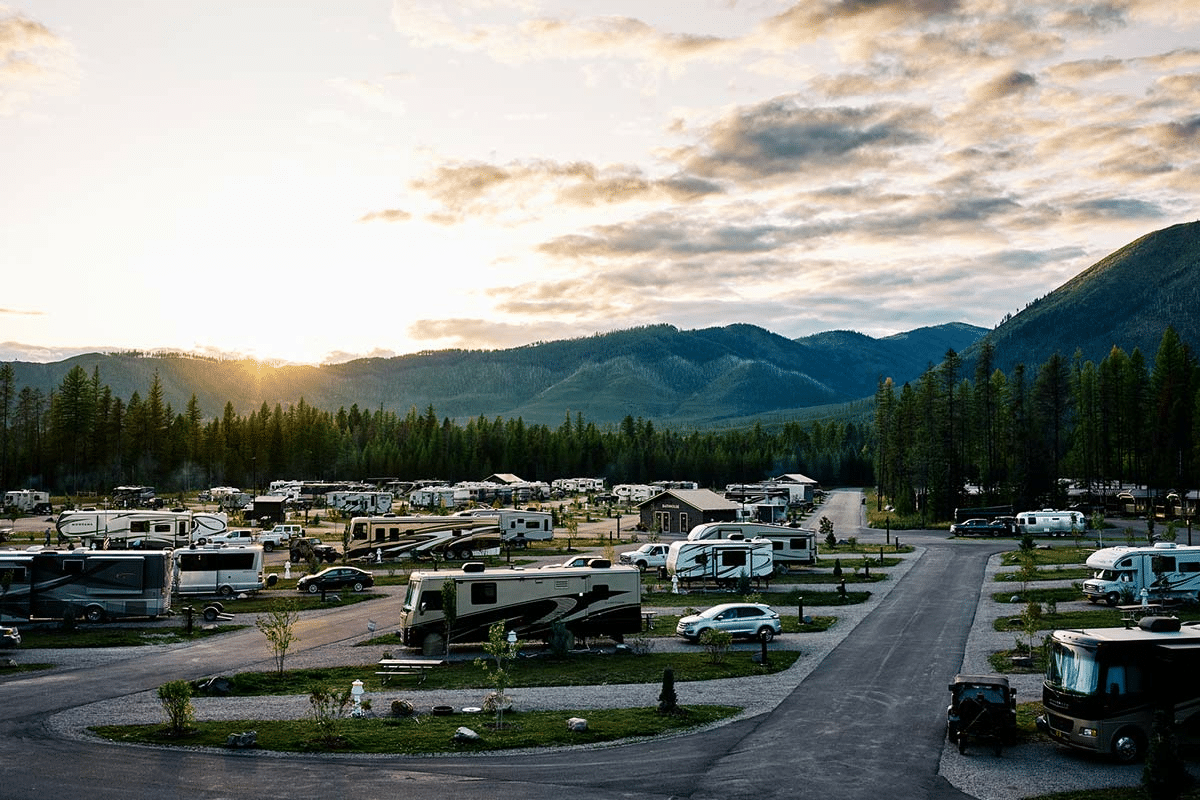
West Glacier RV Park is quietly tucked behind the hustle and bustle of West Glacier Village. They offer full-service sites, spacious pull-thru sites, free Wifi, a dog park, mini golf, and more!
Rates start at $105 per night and West Glacier RV Park is a Good Sam RV Park!
Moose Creek RV Resort and Bed & Breakfast
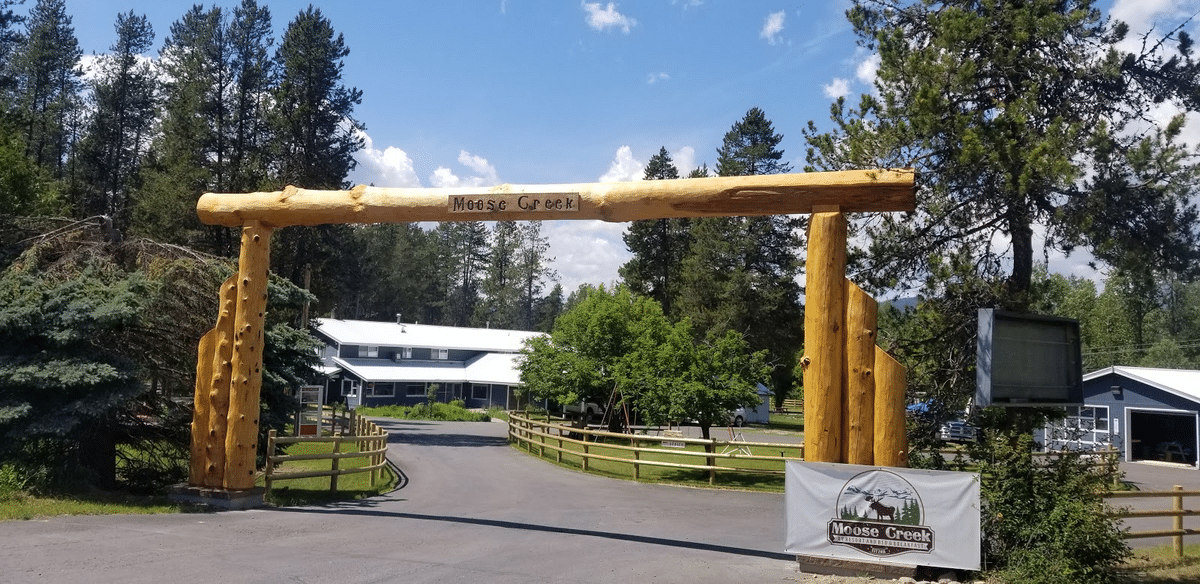
Moose Creek RV Resort and Bed & Breakfast is family-owned and operated and it’s the perfect place to stay when visiting Glacier National Park. They have fresh cinnamon rolls and pies in the morning as well as a nightly campfire.
They’re pet friendly, have tons of amenities, and prices start at $68. What more could you ask for?
Note: Click here if you’re a fan of RV resorts! We wrote about the best 98 in the country.
Final Thoughts
There are plenty of things to do in Glacier National Park and with everything we’ve shared, we feel like we’ve barely scratched the surface!
Have you visited this National Park before? What was your favorite thing to do?
Let us know in the comments below!
Related Reading:

